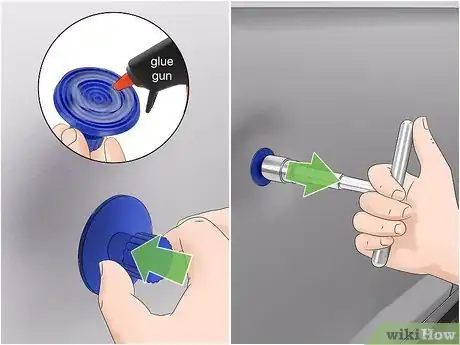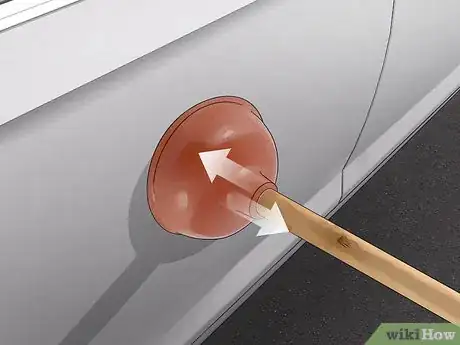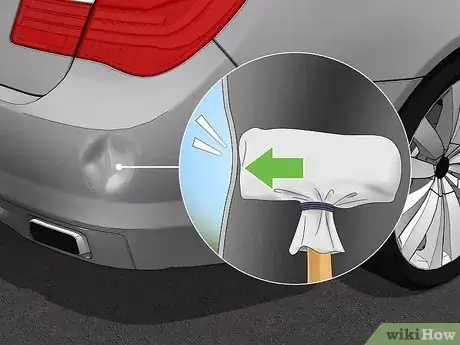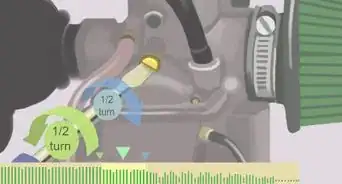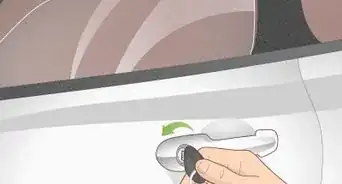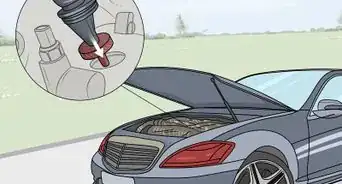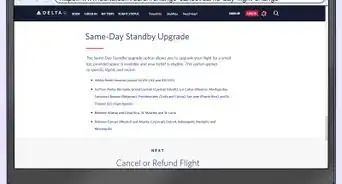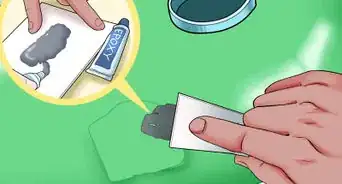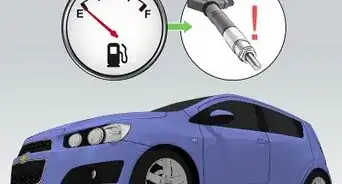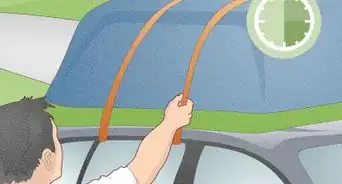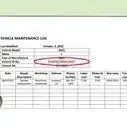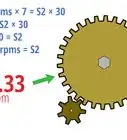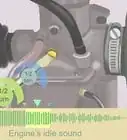This article was co-authored by Charlie Payne and by wikiHow staff writer, Hunter Rising. Charlie Payne is an Auto Repair Expert and the Owner & Operator of Perfect Reflections Auto Body. With over 21 years of experience, he specializes in auto restorations and collision repairs. Charlie is PPG and DuPont certified and earned a Bachelor's Degree from Liberty University.
There are 13 references cited in this article, which can be found at the bottom of the page.
This article has been viewed 48,198 times.
We know it’s the worst feeling when you get into an accident that dings up your vehicle. Luckily, dented quarter panels, or the body sections around your rear wheels, are usually quick cosmetic repairs you can do on your own. You probably have some questions about how to fix the panel, so we’ll cover some of the best things you can do so you barely even notice the damage!
Steps
Can all car dents be fixed?
-
1You can fix most shallow dents as long as they’re just cosmetic. You’ll have the most luck with dents that are small and concave on smooth surfaces. Even if you don’t have a lot of experience repairing vehicles, you may already have the supplies at home to work on minor damage. Some smaller dent repairs only take minutes but others require a bit more patience and hard work to get the panel back to its original shape.[1]
- You may still notice some slight damage from home repairs, which could affect the resale value and overall look of your vehicle.
- Dents that are on the edges of a panel or creases are more difficult to repair on your own. Depending on the location and on the structural damage, it might not be able to repair it.
-
2Take your vehicle to a shop if the dent broke through the clear coat. When you damage the sealant on your vehicle’s body, it’s more likely that it will develop rust and corrosion. Inspect the dent to see if any of the clear coat has worn away or if there’s a tear in the panel. If there is, contact your local auto body shop to get a quote for your repairs.[2]
- You should also take your vehicle into a shop if you don’t feel comfortable working on it yourself.
How do I use a dent removal tool?
-
1Glue the tool’s suction cup to the middle of the dent. Most dent remover kits come with a hot glue gun, a suction cup, and a crossbar used to pull out the damage. Heat up your glue gun and apply hot glue to the bottom of the suction cup. Then, press it flat against the middle of the dent.[3] Let the glue dry for at least 10–30 seconds so it adheres properly.[4]
- You can buy dent remover kits online or at your local automotive supply store. They usually cost around $30–50 USD.
- If your removal tool doesn’t come with a hot glue gun, you may not need to glue the suction cup down. Just push the suction cup hard against the center of the dent so it sticks to your panel.
-
2Attach the crossbar to the suction cup. Slide the suction cup through the hole in the middle of the crossbar. Turn the crossbar so the 2 feet on either side are on a flat area on your quarter panel. Press the feet tightly against the panel so they stick to your vehicle. Then, screw the knob onto the end of the suction cup to keep the crossbar from falling off.[5]
- If you don’t put the feet on a flat surface, they may slide around and won’t pull the dent out.
-
3Turn the suction cup’s knob clockwise to pop the dent out. Only rotate the knob by a half-turn at a time so you’re less likely to damage your vehicle. As you turn the knob, the feet will press against your vehicle’s body and the suction cup will pull the panel out. Keep turning the knob until you see or hear the panel pop back into its original position. Once you pull out the dent, the removal tool will easily come off of the panel.[6]
- If you have glue residue on the panel, heat it up with a hairdryer or heat gun until the glue softens. Then, you can easily wipe or peel the glue off of the panel.[7]
- Sometimes, the removal tool will only pop out a portion of a larger dent. If you can still see damage, reposition the tool’s suction cup to the lowest section of the dent and repeat the process.
How much does it cost to pull out a dent?
-
1Golf ball-sized dents usually cost $150 USD or more. The total price depends on the dent’s location, sharpness, and ease of access. Luckily, they usually only take around an hour to repair. Ask the technician for an estimate when you take your vehicle in since they’ll be able to give you a more accurate price once they see it.[14]
- If you have multiple dents, ask if the auto body shop offers any discounts so you don’t have to pay the full price for each one.
- You may be able to find paintless dent repair services in your area if there’s no damage to your vehicle’s paint job. They usually will come to you so you don’t have to take your vehicle into the shop.
-
2Dents or creases bigger than your hand will cost over $250 USD. Larger dents require a lot more work and the shop may need to remove other parts of your vehicle for the fix. The price also depends on the model of your vehicle and if they need to repaint the surface. When you take your vehicle in, show the repairperson the damage and ask them what the best steps are for moving forward.[15]
- Larger dents may take around 2–4 hours to repair.
- For more severe damage, you may need to have your quarter panel repainted or replaced entirely.
- Sometimes, larger dents affect the structural integrity of your vehicle, which may end up costing you more.
Warnings
- Take your vehicle in if the clear coat is damaged, or else it could develop rust.[17]⧼thumbs_response⧽
References
- ↑ http://knowhow.napaonline.com/how-to-fix-a-fender-bender-quick-fixes-or-waste-of-time/
- ↑ http://knowhow.napaonline.com/an-expert-touch-what-is-paintless-dent-repair-pdr/
- ↑ https://www.caranddriver.com/features/a27409070/how-to-fix-car-dents/
- ↑ https://youtu.be/PjSoUw_g1Pw?t=52
- ↑ https://youtu.be/eLeIsz3zqFY?t=420
- ↑ https://youtu.be/eLeIsz3zqFY?t=441
- ↑ http://knowhow.napaonline.com/how-to-fix-a-fender-bender-quick-fixes-or-waste-of-time/
- ↑ http://knowhow.napaonline.com/how-to-fix-a-fender-bender-quick-fixes-or-waste-of-time/
- ↑ https://blogs.uww.edu/mechanicaladventures/2019/05/01/car-dent-removal/
- ↑ https://blogs.uww.edu/mechanicaladventures/2019/05/01/car-dent-removal/
- ↑ https://www.caranddriver.com/features/a27409070/how-to-fix-car-dents/
- ↑ https://www.autotraining.edu/blog/how-to-hammer-out-dents-completely/
- ↑ https://www.hotrod.com/articles/how-to-pull-dent/
- ↑ https://youtu.be/fSERkvydnJI?t=28
- ↑ https://youtu.be/fSERkvydnJI?t=67
- ↑ https://www.caranddriver.com/features/a27409070/how-to-fix-car-dents/
- ↑ http://knowhow.napaonline.com/how-to-fix-a-dent-in-a-car-and-when-to-bring-it-to-an-expert/

